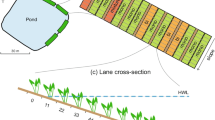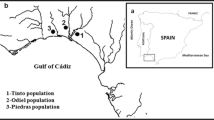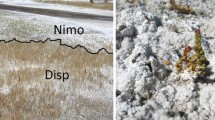Abstract
We investigated the roles of flooding, salinity, and plant competition in creating a bimodal zonation pattern of the marsh dominant annual plant, Suaeda salsa, along coastal topographic gradients on the Pacific coast of northern China. In two consecutive years, we manipulated salinity and flooding, salinity, and competition for S. salsa seedlings that had been transplanted into the mudflat, the high marsh, and the upland, respectively. S. salsa plants that had been transplanted into the mudflat were completely eliminated in the non-elevated treatments whereas they performed much better in the 10 cm elevated treatments, regardless of salinity treatments. Although the performance of S. salsa transplanted into the high marsh did not differ between the fresh (watered) and the salt (control) treatments, S. salsa seedling emergence in the high marsh was nearly completely inhibited in the salt treatments. In contrast, a large number of S. salsa seedlings did emerge in the fresh treatments. S. salsa transplanted into the upland performed well when neighbors were removed, whereas it appeared to be strongly suppressed when neighbors were present. These data indicated that flooding, salinity, and competition all played a role in determining the zonation pattern of S. salsa. Furthermore, the importance of salinity was found to vary with life-history stage. Based on the results from these field manipulative experiments, we suggest that the marsh plant zonation paradigm may hold true for plant distributions along landscape-scale topographic gradients from mudflats to uplands in general. The relative importance of flooding, salinity, and competition, however, may vary at different elevations within a site and between sites.






Similar content being viewed by others
References
Adams, D. A., 1963. Factors influencing vascular plant zonation in North Carolina salt marshes. Ecology 44: 445–456.
Barry, M. J., R. Bowers & F. A. de Szalay, 2004. Effects of hydrology, herbivory and sediment disturbance on plant recruitment in a Lake Erie coastal wetland. American Midland Naturalist 151: 217–232.
Bertness, M. D., 1991a. Interspecific interactions among high marsh perennials in a New England salt marsh. Ecology 72: 125–137.
Bertness, M. D., 1991b. Zonation of Spartina patens and Spartina alterniflora in a New England salt marsh. Ecology 72: 138–148.
Bertness, M. D. & A. M. Ellison, 1987. Determinants of pattern in a New England salt marsh plant community. Ecological Monographs 57: 129–147.
Bertness, M. D. & P. J. Ewanchuk, 2002. Latitudinal and climate-driven variation in the strength and nature of biological interactions in New England salt marshes. Oecologia 132: 392–401.
Bertness, M. D. & S. C. Pennings, 2000. Spatial variation in process and pattern in salt marsh plant communities in eastern North America. In Weinstein, M. P. & D. A. Kreeger (eds), Concepts and Controversies in Tidal Marsh Ecology. Kluwer Academic Publishers, New York: 39–57.
Bertness, M. D., L. Gaugh & S. W. Shumway, 1992. Salt tolerances and the distribution of plants across a New England salt marsh. Ecology 72: 1842–1851.
Caçador, I., S. Tibério & H. Cabral, 2007. Species zonation in Corroios salt marsh in the Tagus estuary (Portugal) and its dynamics in the past fifty years. Hydrobiologia 587: 205–211.
Casanova, M. T. & M. A. Brock, 2000. How do depth, duration and frequency of flooding influence the establishment of wetland plant communities? Plant Ecology 147: 237–250.
Castillo, J. M., E. Mateos-Naranjo, F. J. Nieva & E. Figueroa, 2008. Plant zonation at salt marshes of the endangered cordgrass Spartina maritima invaded by Spartina densiflora. Hydrobiologia 614: 363–371.
Chapman, V. J., 1939. Studies in salt marsh ecology. IV and V. Journal of Ecology 27: 160–201.
Clarke, L. D. & N. J. Hannon, 1969. The mangrove swamp and salt marsh communities of the Sydney district. II. The holocoenotic complex with particular reference to physiography. Journal of Ecology 57: 213–234.
Costa, C. S. B., J. C. Marangoni & A. G. Azevedo, 2003. Plant zonation in irregularly flooded salt marshes: relative importance of stress tolerance and biological interactions. Journal of Ecology 91: 951–965.
Crain, C. M., B. R. Silliman, S. L. Bertness & M. D. Bertness, 2004. Physical and biotic drivers of plant distribution across estuarine salinity gradients. Ecology 85: 2539–2549.
Ewanchuk, P. J. & M. D. Bertness, 2004. Structure and organization of a northern New England salt marsh plant community. Journal of Ecology 92: 72–85.
Gillham, M. E., 1957a. Vegetation of the Exe Estuary in relation to water salinity. Journal of Ecology 45: 735–756.
Gillham, M. E., 1957b. Coastal vegetation of Mull and Iona in relation to salinity and soil reaction. Journal of Ecology 45: 757–778.
Grace, J. B. & R. G. Wetzel, 1981. Habitat partitioning and competitive displacement in cattails (Typha angustifolia): experimental field studies. American Naturalist 118: 463–474.
Grime, J. P., 1977. Evidence for the existence of three primary strategies in plants and its relevance to ecological and evolutionary theory. American Naturalist 111: 1169–1194.
He, Q., B. Cui, X. Zhao & H. Fu, 2008. Niches of plant species in wetlands of the Yellow River Delta under gradients of water table depth and soil salinity. Chinese Journal of Applied Ecology 19: 969–975.
Hellings, S. E. & J. L. Gallagher, 1992. The effects of salinity and flooding on Phragmites australis. Journal of Applied Ecology 29: 41–49.
Houle, G., L. Morel, C. E. Reynolds & J. Siégel, 2001. The effect of salinity on different developmental stages of an endemic annual plant, Aster laurentianus (Asteraceae). American Journal of Botany 88: 62–67.
Huang, H. J. & H. Fan, 2004. Change detection of tidal flats and tidal creeks in the Yellow River Delta using Landsat TM/ETM+ images. Acta Geographica Sinica 59: 723–730.
Hughes, R. G. & O. L. A. Paramor, 2004. The effects of bioturbation and herbivory by the polychaete Nereis diversicolor on loss of saltmarsh in south-east England. Journal of Applied Ecology 41: 440–448.
James, M. L. & J. B. Zedler, 2000. Dynamics of wetland and upland subshrubs at the salt marsh-coastal sage scrub ecotone. American Midland Naturalist 143: 298–311.
Morris, J. T., 1995. The mass balance of salt and water in intertidal sediments: results from North Inlet, South Carolina. Estuaries 18: 556–567.
Paramor, O. L. A. & R. G. Hughes, 2004. On the loss of saltmarshes in south-east England and methods for their restoration. Journal of Applied Ecology 41: 449–463.
Paramor, O. L. A. & R. G. Hughes, 2005. Effects of the invertebrate infauna on early saltmarsh plant colonisation of managed realignment areas in south-east England. Marine Ecology Progress Series 303: 61–71.
Pennings, S. C. & M. D. Bertness, 1999. Using latitudinal variation to examine effects of climate on coastal salt marsh pattern and process. Current Topics in Wetland Biogeochemistry 3: 100–111.
Pennings, S. C. & M. D. Bertness, 2001. Salt marsh communities. In Bertness, M. D., S. D. Gaines & M. Hay (eds), Marine Community Ecology. Sinauer Associates, Sunderland: 289–316.
Pennings, S. C. & R. M. Callaway, 1992. Salt marsh plant zonation: the relative importance of competition and physical factors. Ecology 73: 681–690.
Pennings, S. C. & D. J. Moore, 2001. Zonation of shrubs in western Atlantic salt marshes. Oecologia 126: 587–594.
Pennings, S. C., E. R. Selig, L. T. Houser & M. D. Bertness, 2003. Geographic variation in positive and negative interactions among salt marsh plants. Ecology 84: 1527–1538.
Pennings, S. C., M. B. Grant & M. D. Bertness, 2005. Plant zonation in low-latitude salt marshes: disentangling the roles of flooding, salinity and competition. Journal of Ecology 93: 159–167.
R Development Core Team, 2008. R: A Language and Environment for Statistical Computing. R Foundation for Statistical Computing, Vienna.
Shumway, S. W. & M. D. Bertness, 1992. Salt stress limitation of seedling recruitment in a salt marsh plant community. Oecologia 92: 490–497.
Silvestri, S., A. Defina & M. Marani, 2005. Tidal regime, salinity and salt marsh plant zonation. Estuarine, Coastal and Shelf Science 62: 119–130.
Snow, A. A. & S. W. Vince, 1984. Plant zonation in an Alaskan salt marsh. II. An experimental study of the role of edaphic conditions. Journal of Ecology 72: 669–684.
Song, J., H. Fan, Y. Zhao, Y. Jia, X. Du & B. Wang, 2008. Effect of salinity on germination, seedling emergence, seedling growth and ion accumulation of a euhalophyte Suaeda salsa in an intertidal zone and on saline inland. Aquatic Botany 88: 331–337.
Sun, Y. F., Y. Duan, S. Y. Wu & Z. D. Wang, 2006. Coastal evolution in the north of the Yellow River Delta. Marine Geology Letters 22: 7–11.
Traut, B. H., 2005. The role of coastal ecotones: a case study of the salt marsh/upland transition zone in California. Journal of Ecology 93: 279–290.
Ungar, I. A., 1996. Effect of salinity on seed germination, growth, and ion accumulation of Atriplex patula (Chenopodiaceae). American Journal of Botany 83: 604–607.
Vince, S. W. & A. A. Snow, 1984. Plant zonation in an Alaskan salt marsh. I. Distribution, abundance and environmental factors. Journal of Ecology 72: 651–667.
Wang, H., Y. P. Hsiehb, M. A. Harwell & W. Huang, 2007. Modeling soil salinity distribution along topographic gradients in tidal salt marshes in Atlantic and Gulf coastal regions. Ecological Modelling 201: 429–439.
Webb, E. C., I. A. Mendelssohn & B. J. Wilsey, 1995. Causes for vegetation dieback in a Louisiana salt marsh: a bioassay approach. Aquatic Botany 51: 281–289.
Wilson, S. D. & P. A. Keddy, 1986. Species competitive ability and position along a natural stress/disturbance gradient. Ecology 67: 1236–1242.
Wolters, M., J. P. Bakker, M. D. Bertness, R. L. Jefferies & I. Möller, 2005. Saltmarsh erosion and restoration in south-east England: squeezing the evidence requires realignment. Journal of Applied Ecology 42: 844–851.
Zedler, J. B., J. C. Callaway, J. S. Desmond, G. Vivian-Smith, G. D. Williams, G. Sullivan, A. E. Brewster & B. K. Bradshaw, 1999. Californian salt-marsh vegetation: an improved model of spatial pattern. Ecosystems 2: 19–35.
Zhao, K., H. Fan, S. Zhou & J. Song, 2003. Study on the salt and drought tolerance of Suaeda salsa and Kalanchoe claigremontiana under iso-osmotic salt and water stress. Plant Science 165: 837–844.
Acknowledgments
We thank to people involved in this group study. We are indebted to Hualing Fu, Qiaomu Hu, Wei Li, and Shuqian Yang & Xiaolin Liao for invaluable field and/or laboratory assistance. We also thank the people in the field stations and the Management Bureau of the Yellow River Delta National Nature Reserve for their cordial help with field work. We thank Pierluigi Viaroli and two anonymous reviewers for helpful comments that greatly improved the manuscript. This study was funded by National Key Basic Research Program of China (2006CB403303) and National Natural Science Foundation of China (40571149 and U0833002).
Author information
Authors and Affiliations
Corresponding author
Additional information
Handling editor: Pierluigi Viaroli
Rights and permissions
About this article
Cite this article
He, Q., Cui, B., Cai, Y. et al. What confines an annual plant to two separate zones along coastal topographic gradients?. Hydrobiologia 630, 327–340 (2009). https://doi.org/10.1007/s10750-009-9825-6
Received:
Revised:
Accepted:
Published:
Issue Date:
DOI: https://doi.org/10.1007/s10750-009-9825-6




